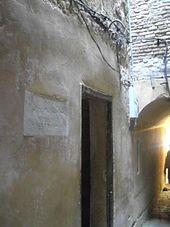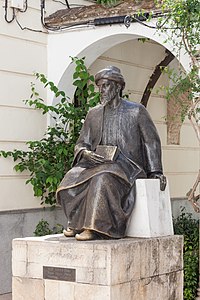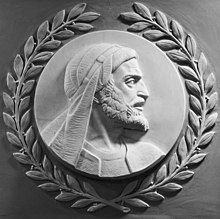A | B | C | D | E | F | G | H | CH | I | J | K | L | M | N | O | P | Q | R | S | T | U | V | W | X | Y | Z | 0 | 1 | 2 | 3 | 4 | 5 | 6 | 7 | 8 | 9
| |
|---|---|
 Purported portrait of Maimonides from which all modern portraits are derived, Thesaurus Antiquitatum Sacrarum c. 1744[1] | |
| Born | 30 March[2] or 6 April[3] 1135 Possibly born 28 March or 4 April[4] 1138 |
| Died | 12 December 1204 (66–69 years old) |
| Notable work | |
| Spouse | (1) daughter of Nathaniel Baruch (2) daughter of Mishael Halevi |
| Era | Medieval philosophy |
| Region | Middle Eastern philosophy |
| School | Aristotelianism |
| Language | Judeo-Arabic, Medieval Hebrew |
Main interests | Theology, Halakha, Astronomy, Medicine |
Notable ideas | Maimonides' rule, Golden mean, 13 principles of faith |
| Signature | |
| Part of a series on the |
| Philosophy of religion |
|---|
| Philosophy of religion article index |
Moses ben Maimon[a] (1138–1204), commonly known as Maimonides (/maɪˈmɒnɪdiːz/ my-MON-ih-deez)[b] and also referred to by the Hebrew acronym Rambam (Hebrew: רמב״ם),[c] was a Sephardic rabbi and philosopher who became one of the most prolific and influential Torah scholars of the Middle Ages. In his time, he was also a preeminent astronomer and physician, serving as the personal physician of Saladin. He was born and lived in Córdoba in al-Andalus (now in Spain) within the Almoravid Empire on Passover eve 1138 or 1135,[d] until his family was expelled for refusing to convert to Islam.[9][10][11] Later, he lived in Morocco and Egypt and worked as a rabbi, physician and philosopher.
During his lifetime, most Jews greeted Maimonides' writings on Jewish law and ethics with acclaim and gratitude, even as far away as Iraq and Yemen. Yet, while Maimonides rose to become the revered head of the Jewish community in Egypt, his writings also had vociferous critics, particularly in Spain. He died in Fustat, Egypt and, according to Jewish tradition, was buried in Tiberias. The Tomb of Maimonides in Tiberias is a popular pilgrimage and tourist site.
He was posthumously acknowledged as one of the foremost rabbinic decisors and philosophers in Jewish history, and his copious work comprises a cornerstone of Jewish scholarship. His fourteen-volume Mishneh Torah still carries significant canonical authority as a codification of Halacha.[12]
Aside from being revered by Jewish historians, Maimonides also figures very prominently in the history of Islamic and Arab sciences. Influenced by Aristotle, Al-Farabi, Ibn Sina, and his contemporary Ibn Rushd, he became a prominent philosopher and polymath in both the Jewish and Islamic worlds.
Name
Maimonides referred to himself as "Moses, son of Rabbi Maimon the Spaniard" (Hebrew: משה ברבי מימון הספרדי).[e] In Medieval Hebrew he was usually called ר״ם, short for "our Rabbi Moshe", but mostly he is called רמב״ם, short for "our Rabbi, Moshe son of Maimon" and pronounced Rambam.
In Arabic, he is sometimes called "Moses 'son of Amram'[f] son of Maimon, of Obadiah,[g] the Cordoban" (أَبُو عَمْرَان مُوسَى بْن مَيْمُون بْن عُبَيْد ٱللّٰه ٱلْقُرْطُبِيّ, Abū ʿImrān Mūsā bin Maimūn bin ʿUbaydallāh al-Qurṭubī), or more often simply "Moses, son of Maimon" (موسى بن ميمون).
In Greek, the Hebrew ben ('son of') becomes the patronymic suffix -ides, forming Μωησής Μαϊμονίδης "Moses Maimonides".[citation needed]
He is sometimes known as "The Great Eagle" (Hebrew: הנשר הגדול, romanized: haNesher haGadol).
Biography
Early years

Maimonides was born 1138 (or 1135) in Córdoba in the Muslim-ruled Almoravid Caliphate at the end of the golden age of Jewish culture in the Iberian Peninsula after the first centuries of Muslim rule. His father, Maimon ben Joseph, was a dayyan or rabbinic judge. Aaron ben Jacob ha-Kohen later wrote that he had traced Maimonides' descent back to Simeon ben Judah ha-Nasi from the Davidic line.[13] His ancestry, going back four generations, is given in his Epistle to Yemen as Moses son of Maimon the Judge, son of Joseph the Wise, son of Isaac the Rabbi, son of Obadiah the Judge.[14] At the end of his commentary on the Mishnah, however, a slightly different genealogy is presented: Moses son of Maimon the Judge, son of Joseph the Wise, son of Isaac the Judge, son of Joseph the Judge, son of Obadiah the Judge, son of Solomon the Rabbi, son of Obadiah the Judge.[e]
Maimonides studied Torah under his father, who had in turn studied under Joseph ibn Migash, a student of Isaac Alfasi. At an early age, Maimonides developed an interest in sciences and philosophy. He read ancient Greek philosophy accessible via Arabic translations and was deeply immersed in the sciences and learning of Islamic culture.[15]
Maimonides, who was revered for his personality as well as for his writings, led a busy life, and wrote many of his works while travelling or in temporary accommodation.[16]
Exile

A Berber dynasty, the Almohads, conquered Córdoba in 1148 and abolished dhimmi status (i.e., state protection of non-Muslims ensured through payment of a tax, the jizya) in some[which?] of their territories. The loss of this status forced the Jewish and Christian communities to choose between conversion to Islam, death, or exile.[16] Many Jews were forced to convert, but due to suspicion by the authorities of fake conversions, the new converts had to wear identifying clothing that set them apart and made them subject to public scrutiny.[18]
Maimonides' family, along with many other Jews,[dubious – discuss] chose exile. For the next ten years, Maimonides moved about in southern Spain and North Africa, eventually settling in Fez, Morocco. Some say that his teacher in Fez was Rabbi Yehuda Ha-Cohen Ibn Susan, until the latter was killed in 1165.[19]
During this time, he composed his acclaimed commentary on the Mishnah, during the years 1166–1168.[h]
Following this sojourn in Morocco, he lived in Palestine with his father and brother, before settling in Fustat in Fatimid Caliphate-controlled Egypt by 1168.[20] There is mention that Maimonides first settled in Alexandria, and moved to Fustat only in 1171. While in Cairo, he studied in a yeshiva attached to a small synagogue, which now bears his name.[21] In Palestine, he prayed at the Temple Mount. He wrote that this day of visiting the Temple Mount was a day of holiness for him and his descendants.[22]
Maimonides shortly thereafter was instrumental in helping rescue Jews taken captive during the Christian Amalric of Jerusalem's siege of the southeastern Nile Delta town of Bilbeis. He sent five letters to the Jewish communities of Lower Egypt asking them to pool money together to pay the ransom. The money was collected and then given to two judges sent to Palestine to negotiate with the Crusaders. The captives were eventually released.[23]
Death of his brother

Following this success, the Maimonides family, hoping to increase their wealth, gave their savings to his brother, the youngest son David ben Maimon, a merchant. Maimonides directed his brother to procure goods only at the Sudanese port of ʿAydhab. After a long, arduous trip through the desert, however, David was unimpressed by the goods on offer there. Against his brother's wishes, David boarded a ship for India, since great wealth was to be found in the East.[i] Before he could reach his destination, David drowned at sea sometime between 1169 and 1177. The death of his brother caused Maimonides to become sick with grief.
In a letter discovered in the Cairo Geniza, he wrote:
The greatest misfortune that has befallen me during my entire life—worse than anything else—was the demise of the saint, may his memory be blessed, who drowned in the Indian sea, carrying much money belonging to me, to him, and to others, and left with me a little daughter and a widow. On the day I received that terrible news I fell ill and remained in bed for about a year, suffering from a sore boil, fever, and depression, and was almost given up. About eight years have passed, but I am still mourning and unable to accept consolation. And how should I console myself? He grew up on my knees, he was my brother, he was my student.[24]
Nagid

Around 1171, Maimonides was appointed the Nagid of the Egyptian Jewish community.[21] Arabist Shelomo Dov Goitein believes the leadership he displayed during the ransoming of the Crusader captives led to this appointment.[25] However he was replaced by Sar Shalom ben Moses in 1173. Over the controversial course of Sar Shalom's appointment, during which Sar Shalom was accused of tax farming, Maimonides excommunicated and fought with him for several years until Maimonides was appointed Nagid in 1195. A work known as "Megillat Zutta" was written by Abraham ben Hillel, who writes a scathing description of Sar Shalom while praising Maimonides as "the light of east and west and unique master and marvel of the generation."[26][27]
Physician
With the loss of the family funds tied up in David's business venture, Maimonides assumed the vocation of physician, for which he was to become famous. He had trained in medicine in both Spain and in Fez. Gaining widespread recognition, he was appointed court physician to al-Qadi al-Fadil, the chief secretary to Sultan Saladin, then to Saladin himself; after whose death he remained a physician to the Ayyubid dynasty.[28]

In his medical writings, Maimonides described many conditions, including asthma, diabetes, hepatitis, and pneumonia, and he emphasized moderation and a healthy lifestyle.[30] His treatises became influential for generations of physicians. He was knowledgeable about Greek and Arabic medicine, and followed the principles of humorism in the tradition of Galen. He did not blindly accept authority but used his own observation and experience.[30] Julia Bess Frank indicates that Maimonides in his medical writings sought to interpret works of authorities so that they could become acceptable.[28] Maimonides displayed in his interactions with patients attributes that today would be called intercultural awareness and respect for the patient's autonomy.[31] Although he frequently wrote of his longing for solitude in order to come closer to God and to extend his reflections—elements considered essential in his philosophy to the prophetic experience—he gave over most of his time to caring for others.[32] In a famous letter, Maimonides describes his daily routine. After visiting the Sultan's palace, he would arrive home exhausted and hungry, where "I would find the antechambers filled with gentiles and Jews I would go to heal them, and write prescriptions for their illnesses until the evening and I would be extremely weak."[33]
As he goes on to say in this letter, even on Shabbat he would receive members of the community. Still, he managed to write extended treatises, including not only medical and other scientific studies but some of the most systematically thought-through and influential treatises on halakha (rabbinic law) and Jewish philosophy of the Middle Ages.[j]
In 1172–74, Maimonides wrote his famous Epistle to Yemen.[34] It has been suggested that his "incessant travail" undermined his own health and brought about his death at 69 (although this is a normal lifespan).[35]
Death

Maimonides died on 12 December 1204 (20th of Tevet 4965) in Fustat. A variety of medieval sources beginning with Al-Qifti maintain that his body was interred near Lake Tiberias, though there is no contemporary evidence for his removal from Egypt. Gedaliah ibn Yahya records that "He was buried in the Upper Galilee with elegies upon his gravestone. In the time of Kimhi, when the sons of Belial rose up to besmirch . . . they did evil. They altered his gravestone, which previously had been inscribed 'choicest of the human race (מבחר המין האנושי)', so that instead it read 'the excommunicated heretic (מוחרם ומין)'. But later, after the provocateurs had repented of their act, and praised this great man, a student repaired the gravestone to read 'choicest of the Israelites (מבחר המין הישראלי)'".[36] Today, Tiberias hosts the Tomb of Maimonides, on which is inscribed "From Moses to Moses arose none like Moses."[37]
Maimonides and his wife, the daughter of Mishael ben Yeshayahu Halevi, had one child who survived into adulthood,[38] Abraham Maimonides, who became recognized as a great scholar. He succeeded Maimonides as Nagid and as court physician at the age of eighteen. Throughout his career, he defended his father's writings against all critics. The office of Nagid was held by the Maimonides family for four successive generations until the end of the 14th century.
A statue of Maimonides was erected near the Córdoba Synagogue.
Maimonides is sometimes said to be a descendant of King David, although he never made such a claim.[39][40]
Works
Mishneh Torah
With Mishneh Torah, Maimonides composed a code of Jewish law with the widest-possible scope and depth. The work gathers all the binding laws from the Talmud, and incorporates the positions of the Geonim (post-Talmudic early Medieval scholars, mainly from Mesopotamia). It is also known as Yad ha-Chazaka or simply Yad (יד) which has the numerical value 14, representing the 14 books of the work. The Mishneh Torah made following Jewish law easier for the Jews of his time, who were struggling to understand the complex nature of Jewish rules and regulations as they had adapted over the years.
Later codes of Jewish law, e.g. Arba'ah Turim by Rabbi Jacob ben Asher and Shulchan Aruch by Rabbi Yosef Karo, draw heavily on Mishneh Torah: both often quote whole sections verbatim. However, it met initially with much opposition.[41] There were two main reasons for this opposition. First, Maimonides had refrained from adding references to his work for the sake of brevity; second, in the introduction, he gave the impression of wanting to "cut out" study of the Talmud,[42] to arrive at a conclusion in Jewish law, although Maimonides later wrote that this was not his intent. His most forceful opponents were the rabbis of Provence (Southern France), and a running critique by Rabbi Abraham ben David (Raavad III) is printed in virtually all editions of Mishneh Torah. Nevertheless, Mishneh Torah was recognized as a monumental contribution to the systemized writing of halakha. Throughout the centuries, it has been widely studied and its halakhic decisions have weighed heavily in later rulings.
Zdroj:https://en.wikipedia.org?pojem=Moshe_Ben_Maimon
>Text je dostupný pod licencí Creative Commons Uveďte autora – Zachovejte licenci, případně za dalších podmínek. Podrobnosti naleznete na stránce Podmínky užití.
Šátek
Beadweaving
Bižuterie
Bolo
Dřevěný motýlek
Deštník
Digitálky
Faléra
Fiží
Text je dostupný za podmienok Creative
Commons Attribution/Share-Alike License 3.0 Unported; prípadne za ďalších
podmienok.
Podrobnejšie informácie nájdete na stránke Podmienky
použitia.

